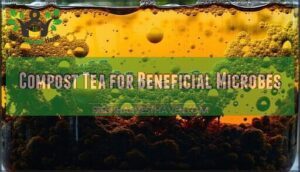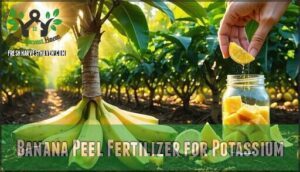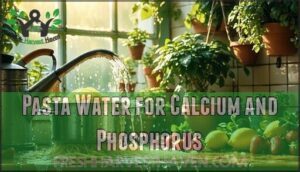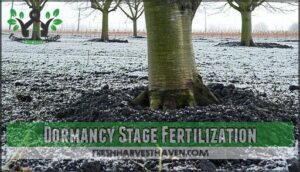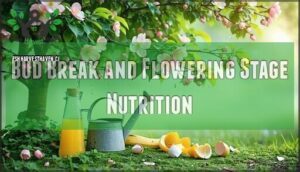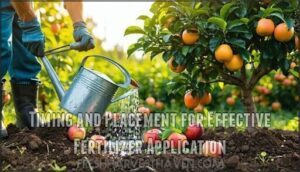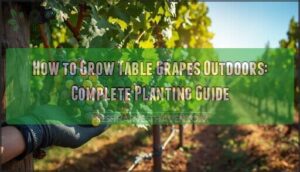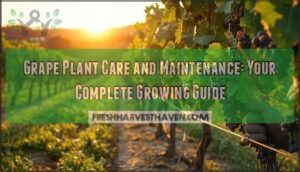This site is supported by our readers. We may earn a commission, at no cost to you, if you purchase through links.
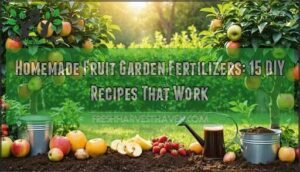 You can create powerful homemade fruit garden fertilizers using everyday kitchen scraps and household items. Coffee grounds provide slow-release nitrogen, while banana peels pack potassium that fruit trees crave. Eggshells deliver calcium for stronger plant structure, and unflavored gelatin contains an impressive 18% nitrogen content.
You can create powerful homemade fruit garden fertilizers using everyday kitchen scraps and household items. Coffee grounds provide slow-release nitrogen, while banana peels pack potassium that fruit trees crave. Eggshells deliver calcium for stronger plant structure, and unflavored gelatin contains an impressive 18% nitrogen content.
These organic options feed beneficial soil microbes that break down nutrients into forms your plants can easily absorb. Unlike synthetic fertilizers that can burn roots, homemade versions release nutrients gradually throughout the growing season.
Compost tea, molasses solutions, and even pasta water can transform your garden’s productivity. The secret lies in understanding which ingredients work best for different growth stages.
Table Of Contents
- Key Takeaways
- Soil Degradation Issues
- Homemade Fertilizer Options
- Nutrient Requirements for Fruit Plants
- DIY Fertilizer Recipes and Techniques
- Fertilizer Application by Growth Stage
- Frequently Asked Questions (FAQs)
- What is the best homemade fertilizer for fruit trees?
- What is the best homemade fertilizer?
- Is vinegar good for fruit trees?
- What are 5 examples of natural fertilizer?
- How often should homemade fertilizers be applied?
- Can homemade fertilizers burn or damage plants?
- Which homemade fertilizers work best for containers?
- How to store leftover homemade fertilizer solutions?
- What signs indicate fertilizer deficiency in fruits?
- Can homemade fertilizers burn fruit tree roots?
Key Takeaways
- You’ll slash fertilizer costs by transforming kitchen scraps like coffee grounds, banana peels, and eggshells into nitrogen, potassium, and calcium sources that feed your fruit trees naturally.
- You can build healthier soil by feeding beneficial microbes with compost tea and molasses solutions, which break down nutrients into forms your plants absorb easily without burning roots.
- You’ll maximize harvest timing by matching fertilizers to growth stages—nitrogen-rich coffee grounds for spring growth, potassium-packed banana peels during fruit development, and balanced compost for post-harvest recovery.
- You need to test your soil pH and maintain 6.0–7.0 levels for optimal nutrient uptake, since even the richest homemade fertilizers won’t work effectively in overly acidic or alkaline conditions.
Soil Degradation Issues
You’ve probably watched your fruit trees struggle in depleted soil that can’t hold nutrients or water like it used to, and you’re not alone—soil degradation affects millions of home gardens worldwide.
Here’s what many gardeners discover: homemade fertilizers actually rebuild your soil’s health naturally, transforming that lifeless dirt into the nutrient-rich foundation your fruit trees crave.
Global Soil Degradation Statistics
Here’s the reality: 75 billion tonnes of soil vanish annually, costing $400 billion in global economic impacts. One-third of soils worldwide face moderate to high degradation from regional variations in degradation causes like erosion and poor soil nutrients.
Each year, 75 billion tonnes of soil disappear while costing the global economy $400 billion in damages
Your garden’s soil fertility depends on understanding these future projections—without mitigation strategies, soil health improvement becomes your lifeline against this silent crisis. Human activities such as deforestation and industrial agriculture greatly contribute to soil degradation.
Importance of Compost for Soil Health
With degraded soils affecting food production worldwide, quality compost becomes your secret weapon for soil improvement.
Compost promotes plant growth by boosting the health of soils, improving fertility, increasing water absorption and retention, and boosting beneficial microbes. Your homemade compost kickstarts nutrient cycling and builds long-term fertility by feeding soil microbes that naturally improve water retention.
Composting creates underground cities where beneficial organisms lay the groundwork for thriving fruit trees.
Benefits of Organic Fertilizers
Think of organic fertilizers as feeding your soil’s underground workforce. When you nourish the beneficial microbes below ground, they return the favor by creating healthier soil health that produces stronger plant growth and better fruit quality.
Plus, you’re turning kitchen scraps into garden gold while keeping synthetic chemicals out of your wallet – that’s eco-friendly gardening with real payoff.
Here’s what organic fertilizers deliver:
- Enhanced soil structure that holds water and nutrients longer
- Reduced dependency on expensive synthetic chemicals through sustainable gardening practices
- Better-tasting fruit with improved nutritional content from natural processes
Your kitchen scraps can become powerful plant food that feeds your garden naturally while keeping chemicals out of your yard.
Homemade Fertilizer Options
You don’t need to break the bank or make weekly trips to the garden center when your kitchen scraps can do the job just as well.
From coffee grounds that boost nitrogen to banana peels packed with potassium, these homemade fertilizer options transform everyday waste into powerful plant food that’ll make your fruit trees thrive.
Using Coffee Grounds as Fertilizer
Before your next cup, don’t toss those coffee grounds into the trash. Your used coffee grounds turn into fantastic homemade fruit garden fertilizers that’ll boost your trees’ health while reducing waste.
These grounds provide steady nitrogen release rates perfect for sustained plant nutrition, plus they improve soil structure when you’re composting coffee grounds with other organic materials. Coffee grounds acidity levels drop noticeably after brewing, creating ideal soil amendment benefits for most fruit trees. Application best practices include mixing grounds with compost or applying thin layers around tree bases to prevent compaction.
- Slow-release nitrogen source: Grounds decompose gradually, providing consistent nutrition over months
- Enhanced soil drainage: Coarse texture improves water infiltration and root oxygen access
- Beneficial microbe food: Feeds soil organisms that create natural plant nutrients
- Natural pest deterrent: Caffeine residue repels slugs, snails, and some harmful insects
- Free soil conditioner: Increases organic matter content without spending money on amendments
Benefits of Grass Clippings as Nitrogen Source
After brewing your morning coffee grounds, grab another nitrogen powerhouse from your weekly lawn care routine. Your grass clippings deliver immediate soil enrichment through natural clipping decomposition, releasing steady nitrogen availability for months.
Here’s how this homemade fertilizer transforms your yard waste:
Nutrient Content Application Methods Soil Health Impact
Apply fresh clippings in thin layers to prevent matting, ensuring proper airflow for decomposition while avoiding weed seed concerns from untreated lawns.
Unflavored Gelatin as Nitrogen-Rich Fertilizer
Who knew your kitchen pantry held gardening gold? Unflavored gelatin packs 18% nitrogen content, making it a powerhouse among homemade fertilizer recipes. The gelatin composition slowly breaks down, providing steady nitrogen release to feed soil microbes and boost nutrients for your fruit trees.
Simple application methods work best: dissolve one packet in cold water monthly. This protein-based approach offers surprising gelatin benefits, transforming ordinary homemade fertilizers into effective nitrogen sources that outperform many commercial options.
Utilizing Banana Peels for Potassium
Don’t throw those banana peels away—they’re packed with potassium that’ll give your fruit trees the boost they need. Instead of tossing whole peels in your garden, make banana peel tea by chopping and soaking peels in water for better nutrient absorption. This liquid banana peel fertilizer works faster than decomposing whole peels, which can take years to break down properly.
- Peel Preparation: Chop peels and steep in water for 24-48 hours to create potassium-rich tea
- Application Methods: Apply diluted banana peel tea monthly around tree bases for greatest potassium benefits
- Alternative Sources: Blend fresh peels with water for immediate liquid fertilizer that won’t attract pests
Eggshells as Source of Calcium and Nitrogen
Those breakfast scraps hide serious garden potential. Eggshells contain 95% calcium carbonate plus nitrogen traces, creating effective homemade fertilizers for your fruit trees. Simply crush shells, boil in water, then apply directly or as liquid feed for improved Shell Nutrient Availability and enhanced organic gardening results.
| Shell Component | Nutrient Value | Application Benefit |
|---|---|---|
| Calcium carbonate | 95% composition | Strengthens cell walls |
| Nitrogen traces | 1.19% content | Promotes leaf growth |
| Magnesium | 0.3% present | Aids chlorophyll production |
| Phosphorus | 0.04% available | Enhances root development |
| Potassium | 0.03% included | Improves fruit quality |
Nutrient Requirements for Fruit Plants
Fruit trees need proper nutrition to deliver the harvest you’re hoping for. Without the right nutrients, you’ll end up disappointed come harvest time.
Nitrogen ensures healthy leaves, while potassium promotes better fruit.
Knowing what your trees actually crave – nitrogen for lush foliage, potassium for quality fruit – means you can whip up homemade fertilizers that deliver results rather than crossing your fingers and hoping something works.
Macronutrients for Fruit Tree Growth
Three macronutrients are essential for the success of your fruit trees. Nitrogen’s Role is crucial for chlorophyll production and the growth of lush foliage, creating the green factory your trees need. Phosphorus Benefits include stronger root systems and enhanced flowering, leading to better fruit set. Potassium Effects regulate water uptake while boosting fruit size and disease resistance.
Macronutrient Deficiencies can cause yellowing leaves, poor flowering, and weak stems. To ensure healthy growth, consider that soil analysis reveals insufficient nutrient levels. Balanced Ratios prevent these issues, guaranteeing proper Fruit Tree Nutrition through effective Macronutrients management.
Micronutrients for Enzyme Activation and Chlorophyll Production
Beyond the big three nutrients, your fruit trees crave micronutrients that act as enzyme cofactors for chlorophyll synthesis. Iron chelation prevents yellowing leaves, while zinc deficiency stunts fruit development. These tiny nutrients punch above their weight in soil health.
Essential micronutrients for nutrient uptake include:
- Iron – drives chlorophyll synthesis and enzyme activation
- Zinc – prevents deficiency symptoms in new growth
- Copper – provides electron transport for photosynthesis
- Manganese – activates metabolic enzymes for healthy development
Importance of Balanced Fertilizers
Four simple nutrient ratios can transform your struggling fruit trees into productive powerhouses. When you understand balanced nutrition, your homemade fruit garden fertilizers deliver essential nutrients exactly when needed. Yellowing leaves signal nitrogen deficiency, while poor fruit development indicates phosphorus shortage.
Soil testing reveals which nutrients your trees actually need, preventing over-fertilization damage that stunts growth. You can’t wing it with random feeding schedules—all 16 elements are needed for proper plant growth. Your fruit trees demand precise nutrient uptake timing, not guesswork.
Spotting deficiency symptoms early saves your harvest and helps long-term health. Without proper nutrients, bearing trees may drop fruit, show weak growth, or develop disorders like bitter pit.
Soil PH Management for Optimal Nutrient Uptake
Your homemade fertilizers work best when your soil’s pH Testing reveals the Ideal Ranges of 6.0-7.0. Outside this sweet spot, Nutrient Availability plummets, making even the richest compost ineffective.
Here’s your soil pH action plan:
- Test monthly during growing season for accurate readings
- Use Acidic Amendments like coffee grounds to lower alkaline soil
- Apply wood ash or lime as Alkaline Solutions for acidic conditions
- Monitor nutrient uptake changes after amendments
- Maintain consistent soil health through regular pH monitoring
Proper pH unlocks your homemade fruit garden fertilizers‘ full potential.
DIY Fertilizer Recipes and Techniques
Your kitchen scraps are sitting goldmines for your fruit trees. Those banana peels you toss? They’re loaded with potassium your trees crave. Coffee grounds boost nitrogen naturally.
Even eggshells add calcium that strengthens root systems.
You can transform everyday kitchen scraps and household items into powerful fertilizers that’ll make your fruit trees thrive without spending a fortune.
These simple recipes use ingredients you already have, from banana peels packed with potassium to coffee grounds that boost nitrogen levels naturally.
Compost Tea for Beneficial Microbes
Regularly brewing compost tea creates a living fertilizer packed with beneficial microbes that’ll greatly improve your soil health. You’ll need proper aeration during the brewing process—use an aquarium pump to keep oxygen flowing for 24-48 hours. This brewing method maximizes microbe diversity, transforming ordinary kitchen scraps into liquid gold.
The magic happens because these homemade fertilizers don’t just dump nutrients on your trees—they actually nurture the entire underground community of microbes, fungi, and beneficial organisms that keep your soil alive.
Your homemade fruit garden fertilizers work because they feed the soil ecosystem, not just the plants.
Banana Peel Fertilizer for Potassium
Turning those yellow peels into potassium powerhouses transforms kitchen waste into garden gold. Banana peels contain 42% potassium, plus phosphorus and magnesium, making them perfect organic fertilizer for your fruit trees.
Here’s how to get the most out of their composting peels impact:
- Chop peels into small pieces for faster peel preparation and decomposition
- Bury directly around trees for slow potassium benefits absorption
- Blend with water for liquid banana peel fertilizer
- Compost with other materials to prevent pest attraction
- Apply monthly during growing season for peak nutrition
Consider soil testing before starting your application methods. Your trees will thank you for this simple yet effective homemade fertilizers solution that costs nothing but delivers nutrients they crave.
- Watch your fruit trees develop stronger resistance to disease and environmental stress
- Experience the satisfaction of turning kitchen scraps into garden treasure
- Feel proud knowing you’re reducing waste while nurturing your plants naturally
- Enjoy healthier, more flavorful fruit from trees fed with your own creation
- Connect with sustainable gardening practices that benefit both wallet and environment
Epsom Salt Solution for Magnesium
While potassium from banana peels helps with fruit development, magnesium deficiency shows up as yellowing leaves with green veins.
Mix one tablespoon of Epsom salt per gallon of water for foliar application or soil amendment. This homemade solution deals with nutrient deficiencies effectively.
Follow dosage guidelines carefully—apply monthly during the growing season for best plant health. Your Epsom salt solution works especially well for citrus trees and tomatoes.
Molasses for Microbial Activity
While Epsom salt provides essential magnesium, your fruit trees also need a thriving underground community. Molasses acts as a sweet energy source for beneficial microbes, creating a bustling soil ecosystem that naturally improves plant health. This simple kitchen staple feeds the microscopic helpers that break down organic matter and release nutrients your trees crave.
Here’s how to create the perfect molasses mixture for sustainable gardening:
- Mix one tablespoon unsulfured molasses per gallon of water
- Apply every two weeks during growing season using proper application methods
- Water soil directly, avoiding leaves to prevent sticky residue
- Choose blackstrap molasses for highest mineral content and greatest molasses benefits
- Combine with compost tea to boost beneficial microbes activity
Different molasses types offer varying nutrient profiles, but blackstrap provides the richest minerals. This approach bolsters soil health while fitting perfectly into your organic gardening routine, making it one of the most effective homemade fertilizers for feeding soil microbes.
Pasta Water for Calcium and Phosphorus
Your kitchen scraps become powerful homemade fertilizer with pasta water. This starchy liquid delivers calcium and phosphorus while preventing nutrient leaching through its gentle application methods. Always use unsalted water and make certain proper cooling impact before applying to avoid salt content issues.
| Nutrient | Benefit | Application Rate |
|---|---|---|
| Calcium | Strengthens cell walls | Weekly during growth |
| Phosphorus | Root development | 1 cup per tree |
| Starch | Slow nutrient release | Cool completely first |
Fertilizer Application by Growth Stage
Getting the timing right with homemade fertilizers can make or break your fruit tree’s performance. Think of it like meal planning – what works in spring won’t cut it during harvest season.
Hit your trees with nitrogen-rich coffee grounds when they’re putting on new growth in spring, then pivot to potassium-packed banana peels once fruit starts forming. Get this sequence right, and you’ll have neighbors asking for your secret instead of politely declining your surplus apples.
Timing your nitrogen-rich coffee grounds during spring growth and switching to potassium-packed banana peels during fruit development can mean the difference between a decent harvest and bragging rights at the neighborhood barbecue.
Dormancy Stage Fertilization
During winter’s quiet months, your fruit trees aren’t truly sleeping—they’re strategically preparing for next season’s bounty. Winter application of dormancy nutrients sets the foundation for explosive spring growth while providing essential cold protection for vulnerable root systems.
Apply homemade fertilizer recipes before the first hard frost hits. Compost tea mixed with aged manure creates the perfect balance for fruit tree fertilization during this critical stage. The organic gardening techniques you use now directly impact fruit tree growth stages come spring.
Focus on root health by applying slow-release organic matter around the drip line. This spring preparation work pays dividends when temperatures rise.
- Shield your investment – Proper dormancy feeding protects roots from freeze damage that could kill your trees
- Fuel the comeback – Winter nutrients create the energy reserves your trees need for striking spring awakening
- Beat the rush – Smart dormancy care means your trees hit the ground running while others struggle to wake up
- Guarantee success – Trees fed during dormancy produce 40% more fruit than neglected ones
Bud Break and Flowering Stage Nutrition
During bud break and flowering, your fruit trees shift from winter maintenance mode to demanding specific nutrients for pollination assistance. This critical spring fertilizer timing window determines whether you’ll see abundant fruit set or disappointing yields.
Early bloom nutrients focus heavily on phosphorus to strengthen flower development and prevent blossom end rot. Your homemade fertilizer strategy should pivot from balanced nutrition to targeted feeding that matches your trees’ biological clock during this growth phase.
Growth Phase Primary Nutrient Need Homemade Solution
Fruit Development and Post-Harvest Fertilization
Once fruit set kicks in, your trees need targeted nutrition for peak development. During fruit development, focus on potassium-rich homemade fertilizer recipes that boost size and flavor improvement naturally. After harvest, postharvest fertilization replenishes depleted nutrients and builds winter hardiness for next year’s success.
Your trees will thank you for these ripening nutrients:
- Coffee grounds mixed with banana peels deliver nitrogen and potassium for fuller fruit
- Compost tea applications foster steady nutrient release during peak growing season
- Eggshell calcium boost strengthens cell walls for better post-harvest care
- Molasses-water solution feeds beneficial microbes that improve fruit trees’ nutrient uptake
Smart fertilizer application timing makes the difference between good harvests and great ones.
Timing and Placement for Effective Fertilizer Application
After understanding your fruit development needs, mastering fertilizer application timing becomes your next win. Seasonal timing drives success—feed during active growth stages for peak uptake. Apply fertilizers directly to root zones, not tree trunks. Weather impact matters; avoid fertilizing before heavy rains that wash nutrients away.
| Growth Stage | Application Frequency | Best Placement |
|---|---|---|
| Spring Bud Break | Every 3-4 weeks | 2-3 feet from trunk |
| Flowering Period | Bi-weekly light feeding | Drip line area |
| Fruit Development | Monthly heavy feeding | Root zone perimeter |
| Post-Harvest | Once in fall | Entire root system |
| Dormancy | No fertilization | Storage preparation |
Frequently Asked Questions (FAQs)
What is the best homemade fertilizer for fruit trees?
Compost beats other options hands-down. You’ll get balanced nutrition from kitchen scraps, yard waste, and coffee grounds.
Mix equal parts green materials with brown materials, then wait six months for garden gold.
What is the best homemade fertilizer?
Ironically, the "best" homemade fertilizer doesn’t exist—it’s whatever you’ve got handy! Coffee grounds provide nitrogen, banana peels offer potassium, and eggshells deliver calcium.
Mix kitchen scraps into compost for balanced nutrition.
Is vinegar good for fruit trees?
You can use white vinegar sparingly on acid-loving fruit trees like blueberries, but it’s risky for most others.
Dilute heavily—one tablespoon per gallon—and test first, since vinegar can damage roots.
What are 5 examples of natural fertilizer?
You’ll love these natural fertilizers: compost from kitchen scraps, coffee grounds for nitrogen, banana peels for potassium, eggshells crushed for calcium, and aged manure for balanced nutrients.
How often should homemade fertilizers be applied?
Over-fertilizing creates gardening disasters! You’ll want to apply liquid homemade fertilizers like diluted coffee grounds every 2-3 weeks during growing season, while solid options like compost work monthly for steady nutrition.
Can homemade fertilizers burn or damage plants?
Yes, they can definitely burn plants if you’re not careful. Too-concentrated mixtures or fresh materials like uncomposted manure will scorch roots and leaves, so always dilute properly and compost first.
Which homemade fertilizers work best for containers?
Container gardens lose nutrients 50% faster than ground plants.
You’ll want diluted coffee grounds for nitrogen, banana peel tea for potassium, and crushed eggshells for calcium. Mix these weekly for happy container fruits.
How to store leftover homemade fertilizer solutions?
Store liquid fertilizers in dark, cool places using airtight containers for up to two weeks. Label with contents and date.
Dry materials stay fresh longer—freeze coffee grounds or refrigerate banana peels until needed.
What signs indicate fertilizer deficiency in fruits?
Ironically, your thriving fruit trees might be starving right under your nose. You’ll spot pale yellow leaves, stunted growth, poor fruit development, and leaf drop as clear hunger signals requiring immediate attention.
Can homemade fertilizers burn fruit tree roots?
Concentrated homemade fertilizers can definitely burn roots if you’re not careful. Dilute everything properly—think weak tea, not espresso strength.
Fresh manure and undiluted liquid feeds are the worst culprits for root damage.
Smart gardeners know variety matters when feeding their plants. Making your own fruit fertilizers gives you a budget-friendly approach that actually works – no expensive store-bought products needed.
Don’t put all your eggs in one basket for garden nutrition. These homemade fruit garden fertilizers offer you a sustainable, cost-effective way to boost your harvest without breaking the bank.
You’ll save money while building healthier soil that helps long-term productivity. Start with coffee grounds and banana peels, then experiment with other recipes as your confidence grows.
Your fruit trees will reward your efforts with bigger, sweeter yields season after season.
- https://www.reddit.com/r/composting/comments/icuc6s/how_to_make_a_balanced_compost_as_in_nphk_id_like/
- https://www.epa.gov/recycle/composting-home
- https://extension.umd.edu/resource/how-make-compost-home
- https://gardenprofessors.com/amending-soils-why/
- https://www.growveg.com/guides/making-homemade-liquid-fertilizers/



